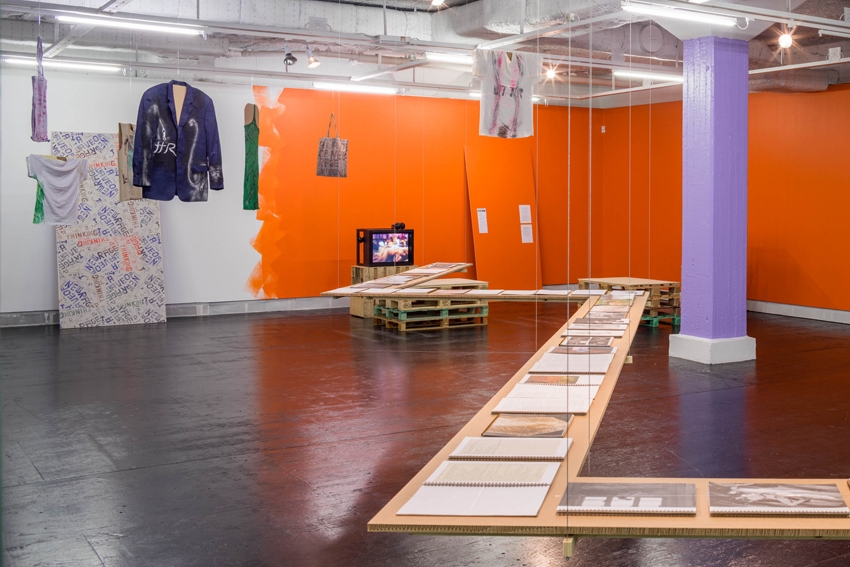Here We LTTR: 2002–2008 at Tensta konsthall joins the ranks of recent exhibitions at Tensta Konsthall, the art centre headed by (ArtReview contributor) Maria Lind, that are in various ways connected to local or temporary communities. Tensta is a Stockholm suburb known for its 1960s-era modernist housing projects, which has since turned into a ghetto segregated from the rest of the city. The show Tensta Museum: Reports from New Sweden (2014) focused on the area’s history and its increasing economic and social disparity; Ane Hjort Guttu’s film This Place is Every Place (2014) in turn established a connection between the Arab Spring and the riots in Tensta in 2013.
The current LTTR retrospective centres on the eponymous journal published over a six-year span by the genderqueer feminist collective formed by artists Ginger Brooks Takahashi, K8 Hardy, Ulrike Müller, Emily Roysdon (now a professor at Konstfack in Stockholm) and Lanka Tattersall (who joined for the fourth issue), together with more than a hundred contributors from their community, invited and selected through open calls. The group’s acronym is painted in large black brushstrokes on a wall at the entrance to the exhibition. A shifting code defying fixed definitions, it has stood for Lesbians To The Rescue and Listen Translate Translate Record, among other things. Inside the open exhibition space, the total of five journals, diversified in design, are laid out on zigzag-shaped MDF shelves suspended from the ceiling, and in Plexiglas vitrines, their substructures covered with pale-pink-coloured cloth. The texts, drawings and artist multiples in the open magazines include Zoe Leonard’s ‘I want a dyke for president’ (1992) and, from 2005, Liz Collins’s knitted red Merger Glove, directing the wearer’s hand into surprising configurations. Hanging freely in the space are embellished T-shirts and tote bags that were sold to finance the project; on an iPad, the out-of-print editions of the journal can be browsed, digitised by Tensta Konsthall and available also on LTTR’s website, which has been redesigned for the exhibition.
Alongside the journal-related items, the show includes videos such as Itziar Okariz’s To Pee in Public Places (2001–6) and Lynda Benglis’s Now (1973) that LTTR presented at screenings it organised at, among other places, Mix NYC and the London Lesbian and Gay Film Festival in 2005 and 2006. These are shown on two monitors installed on wooden pallets, architectural elements that recur in a reading lounge covered with pillows in hand-screenprinted cases bearing the words ‘New Rage Thinking’. The do-it-yourself aesthetics and temporary feel of the exhibition design (by architect Sara Brolund de Carvalho) mirror the collective’s working ethos. Just as there is no fixed meaning to the acronym, the relations between the elements in the space appear mutable, reflecting LTTR’s blurring of borders between art, fanzine and critique, and their quest to find new terms for negotiating sex, gender and the relationships between individuals and groups.
Here We LTTR: 2002–2008 demonstrates that fun and politics, rigour and promiscuity are not opposites, as Roysdon states in an interview printed in the exhibition booklet. The show exemplifies the group’s approach, which engages the things its members want to see changed, such as normative thinking and prejudices with regard to gender concepts, with humour, joyfulness and perversion. And so a lo-fi stereo system placed on one of the vitrines plays back the CD accompanying the second journal, including Who Let the Dykes Out? (2003), a persiflage of the Baha Men hit from 2000. Perhaps most strikingly, the exhibition traces the networks of a community through email correspondence, snapshots registering get-togethers, bank account statements and contracts with, among others, Printed Matter, who published LTTR’s fourth issue. It shows how, in pre-social-network times as well as today, a community’s enthusiasm, desire and pleasure can indeed be political tools, for all that they can also be channelled into commodity form.
In a Sweden currently shaken by rightwing populist propaganda, with the far-right Sweden Democrats, who polled 13 percent in national elections, plastering the partially publicly owned metro with anti-immigrant campaigns (lawfully!), exhibitions like this one can provide that crucial norm-critical toolbox for creating a different space, without prescribing what that space might be.
This article was first published in the October 2015 issue.
